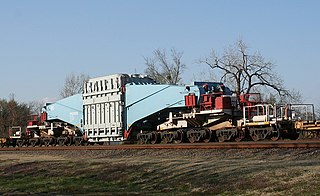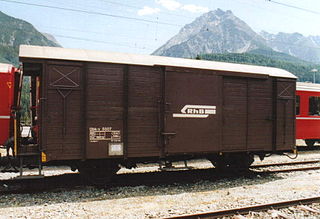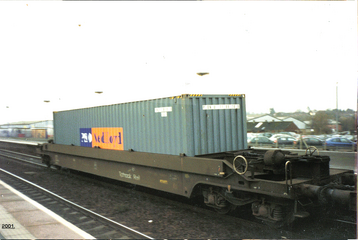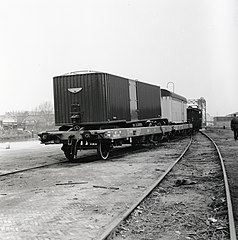
A railroad car, railcar, railway wagon, railway carriage, railway truck, railwagon, railcarriage or railtruck, also called a train car, train wagon, train carriage or train truck, is a vehicle used for the carrying of cargo or passengers on a rail transport network. Such cars, when coupled together and hauled by one or more locomotives, form a train. Alternatively, some passenger cars are self-propelled in which case they may be either single railcars or make up multiple units.

A flatcar (US) is a piece of rolling stock that consists of an open, flat deck mounted on a pair of trucks (US) or bogies (UK), one at each end containing four or six wheels. Occasionally, flat cars designed to carry extra heavy or extra large loads are mounted on a pair of bogies under each end. The deck of the car can be wood or steel, and the sides of the deck can include pockets for stakes or tie-down points to secure loads. Flatcars designed for carrying machinery have sliding chain assemblies recessed in the deck.

A Schnabel car or Schnabel wagon is a specialized type of railroad freight car. It is designed to carry heavy and oversized loads in such a way that the load makes up part of the car. The load is suspended between the two ends of the cars by lifting arms; the lifting arms are connected to an assembly of span bolsters that distribute the weight of the load and the lifting arm over many wheels.

Rail freight transport is the use of railways and trains to transport cargo as opposed to human passengers.

A semi-trailer is a trailer without a front axle. The combination of a semi-trailer and a tractor truck is called a semi-trailer truck.
A specialized set of jargon describe the tools, equipment, and employment sectors used in the trucking industry in the United States. Some terms may be used within other English-speaking countries, or within the freight industry in general. For example, shore power is a term borrowed from shipping terminology, in which electrical power is transferred from shore to ship, instead of the ship relying upon idling its engines. Drawing power from land lines is more efficient than engine idling and eliminates localized air pollution. Another borrowed term is "landing gear", which refers to the legs which support the front end of a semi-trailer when it is not connected to a semi-truck. Some nicknames are obvious wordplay, such as "portable parking lot", in reference to a truck that carries automobiles.

The German term Verbandsbauart describes both a type of goods wagon as well as a type of tram.

Goods wagons or freight wagons, also known as goods carriages, goods trucks, freight carriages or freight trucks, are unpowered railway vehicles that are used for the transportation of cargo. A variety of wagon types are in use to handle different types of goods, but all goods wagons in a regional network typically have standardized couplers and other fittings, such as hoses for air brakes, allowing different wagon types to be assembled into trains. For tracking and identification purposes, goods wagons are generally assigned a unique identifier, typically a UIC wagon number, or in North America, a company reporting mark plus a company specific serial number.
The so-called Austauschbauart wagons were German railway vehicles produced from the late 1920s onwards which had common components built to agreed standards.

Open wagons form a large group of railway goods wagons designed primarily for the transportation of bulk goods that are not moisture-retentive and can usually be tipped, dumped or shovelled. The International Union of Railways (UIC) distinguishes between ordinary wagons and special wagons (F/6). Open wagons often form a significant part of a railway company's goods wagon fleet; for example, forming just under 40% of the Deutsche Bahn's total goods wagon stock in Germany.

Flat wagons, as classified by the International Union of Railways (UIC), are railway goods wagons that have a flat, usually full-length, deck and little or no superstructure. By contrast, open wagons have high side and end walls and covered goods wagons have a fixed roof and sides. Flat wagons are often designed for the transportation of goods that are not weather-sensitive. Some flat wagons are able to be covered completely by tarpaulins or hoods and are therefore suitable for the transport of weather-sensitive goods. Unlike a "goods wagon with opening roof", the loading area of a flat is entirely open and accessible once the cover is removed.

A covered goods wagon or covered goods van is a railway goods wagon which is designed for the transportation of moisture-susceptible goods and therefore fully enclosed by sides and a fixed roof. They are often referred to simply as covered wagons, and this is the term used by the International Union of Railways (UIC). Since the introduction of the international classification for goods wagons by the UIC in the 1960s a distinction has been drawn between ordinary and special covered wagons. Other types of wagon, such as refrigerated vans and goods wagons with opening roofs, are closely related to covered wagons from a design point of view. Similar freight cars in North America are called boxcars.

The fleet of Great Western Railway wagons was both large and varied as it carried the wide variety of goods traffic on the Great Western Railway (GWR) in the United Kingdom. This was the railway company that operated for the longest period of time in the country and covered a large geographical area that included big cities such as London, industrialised areas including the West Midlands, areas of coal and mineral mining such as South Wales, and Somerset and other important agricultural districts. In 1902 the company owned 59,036 wagons, and by 1926 this had risen to 88,580.
Public Joint-Stock Company Stakhanov Railway Car Building Works is an industrial enterprise of Ukraine, located in the city of Kadiivka, Luhansk Oblast, producing freight cars. By 2016, due to the War in Donbas, the plant was seized by the LNR and turned into an insurgent base, with the plant equipment partially dismantled and removed.
The Victorian Railways in Australia have had a vast range of hopper-type wagons over the last century, for transporting anything from grains through fuel to various powders.
The wagon with opening roof is a type of railway goods wagon that is, nowadays, defined and standardised by the International Union of Railways (UIC) as Class "T". They are a large category of rail vehicle, predominantly used for the transport of hygroscopic bulk commodities such as cement, plaster, lime, potash and grain.
The Victorian Railways used a variety of air-cooled and iced wagons or refrigerated vans for the transport of all manner of goods. This page covers the history and development of the various classes, and how they changed through their lives.
Goods wagons of welded construction were developed and built by the Deutsche Reichsbahn in Germany from 1933 to about 1945. With the introduction of welding technology in 1933 almost all wagon components were joined by welding and no longer by rivetting. This enabled goods wagons to be designed, for example, for higher speeds or for higher payloads through the use of different types of steel and other engineering changes, but their further development was so heavily influenced by the exigencies of the Second World War that, as early as 1939, the Deutsche Reichsbahn had to temper the design of goods wagons to the new economic circumstances. Because there were overlaps in the change from the Austauschbauart - goods wagons made with interchangeable components - to the new welded classes, the period of the changeover cannot be exactly defined. Several standard goods wagons and their classes are covered in other articles. Goods wagons built during the Second World War that were purely intended for military transport use, are covered under the article on Kriegsbauart - wartime classes.
The Victorian Railways used a variety of former traffic wagons around depots and for specific construction, maintenance and similar tasks. Very few of these vehicles were specially constructed from scratch, often instead recycling components or whole wagon bodies and frames from old vehicles that had been withdrawn from normal service as life-expired or superseded by a better design.
A pocket wagon is a freight wagon that has been specially designed for the transport of truck semi-trailers. This wagon belongs to the group of flat wagons in special design with bogies and is used in combined transport (CT). The name of these freight wagons comes from the fact that between the narrow longitudinal girders on the outside and also lengthways between the bogies, the so-called pockets are located, in which the wheels of the semi-trailers are particularly low. For flexible use in CT, pocket wagons have hinged latches with ISO spigots on the solebar, so that containers and swap bodies up to 45 ft can be accommodated. As a flat wagon, it bears the UIC generic letter S and, since it is intended for the transport of road vehicles on one level, the code letter d. Since it is also possible to transport containers in a pocket wagon, it bears the UIC generic mark Sdgs. In this context, the code letter g stands for "containers up to 60 feet" and the lower case s for the permitted speed of up to 100 km/h (62 mph). The wagons have a yellow triangle with a black P on the long side. The first pocket wagons were built in Germany as early as 1972 and further developed according to requirements.






















